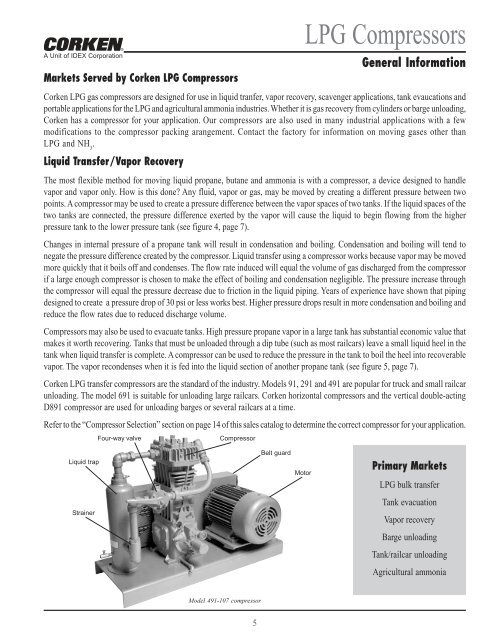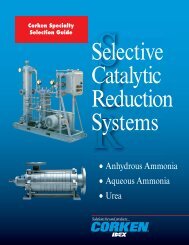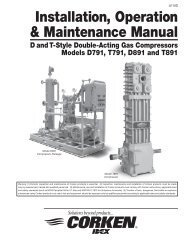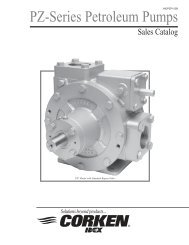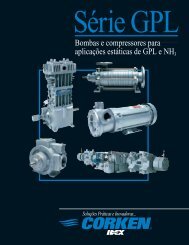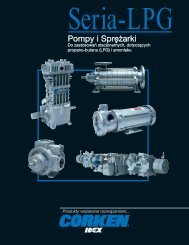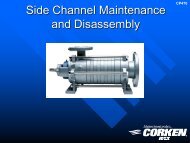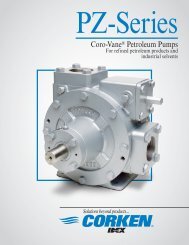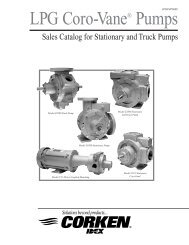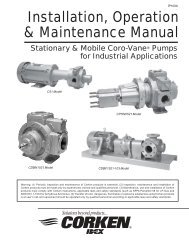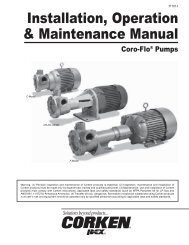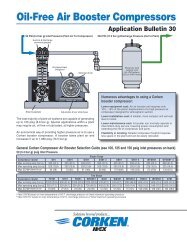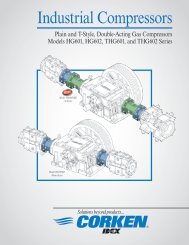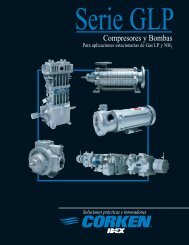Sales Catalog for LPG Compressors - Corken
Sales Catalog for LPG Compressors - Corken
Sales Catalog for LPG Compressors - Corken
You also want an ePaper? Increase the reach of your titles
YUMPU automatically turns print PDFs into web optimized ePapers that Google loves.
A Unit of IDEX Corporation<br />
Markets Served by <strong>Corken</strong> <strong>LPG</strong> <strong>Compressors</strong><br />
<strong>LPG</strong> <strong>Compressors</strong><br />
<strong>Corken</strong> <strong>LPG</strong> gas compressors are designed <strong>for</strong> use in liquid tranfer, vapor recovery, scavenger applications, tank evaucations and<br />
portable applications <strong>for</strong> the <strong>LPG</strong> and agricultural ammonia industries. Whether it is gas recovery from cylinders or barge unloading,<br />
<strong>Corken</strong> has a compressor <strong>for</strong> your application. Our compressors are also used in many industrial applications with a few<br />
modifications to the compressor packing arangement. Contact the factory <strong>for</strong> in<strong>for</strong>mation on moving gases other than<br />
<strong>LPG</strong> and NH 3<br />
.<br />
Liquid Transfer/Vapor Recovery<br />
General In<strong>for</strong>mation<br />
The most flexible method <strong>for</strong> moving liquid propane, butane and ammonia is with a compressor, a device designed to handle<br />
vapor and vapor only. How is this done? Any fluid, vapor or gas, may be moved by creating a different pressure between two<br />
points. A compressor may be used to create a pressure difference between the vapor spaces of two tanks. If the liquid spaces of the<br />
two tanks are connected, the pressure difference exerted by the vapor will cause the liquid to begin flowing from the higher<br />
pressure tank to the lower pressure tank (see figure 4, page 7).<br />
Changes in internal pressure of a propane tank will result in condensation and boiling. Condensation and boiling will tend to<br />
negate the pressure difference created by the compressor. Liquid transfer using a compressor works because vapor may be moved<br />
more quickly that it boils off and condenses. The flow rate induced will equal the volume of gas discharged from the compressor<br />
if a large enough compressor is chosen to make the effect of boiling and condensation negligible. The pressure increase through<br />
the compressor will equal the pressure decrease due to friction in the liquid piping. Years of experience have shown that piping<br />
designed to create a pressure drop of 30 psi or less works best. Higher pressure drops result in more condensation and boiling and<br />
reduce the flow rates due to reduced discharge volume.<br />
<strong>Compressors</strong> may also be used to evacuate tanks. High pressure propane vapor in a large tank has substantial economic value that<br />
makes it worth recovering. Tanks that must be unloaded through a dip tube (such as most railcars) leave a small liquid heel in the<br />
tank when liquid transfer is complete. A compressor can be used to reduce the pressure in the tank to boil the heel into recoverable<br />
vapor. The vapor recondenses when it is fed into the liquid section of another propane tank (see figure 5, page 7).<br />
<strong>Corken</strong> <strong>LPG</strong> transfer compressors are the standard of the industry. Models 91, 291 and 491 are popular <strong>for</strong> truck and small railcar<br />
unloading. The model 691 is suitable <strong>for</strong> unloading large railcars. <strong>Corken</strong> horizontal compressors and the vertical double-acting<br />
D891 compressor are used <strong>for</strong> unloading barges or several railcars at a time.<br />
Refer to the “Compressor Selection” section on page 14 of this sales catalog to determine the correct compressor <strong>for</strong> your application.<br />
Four-way valve<br />
Compressor<br />
Liquid trap<br />
Strainer<br />
Belt guard<br />
Motor<br />
Primary Markets<br />
<strong>LPG</strong> bulk transfer<br />
Tank evacuation<br />
Vapor recovery<br />
Barge unloading<br />
Tank/railcar unloading<br />
Agricultural ammonia<br />
Model 491-107 compressor<br />
5


